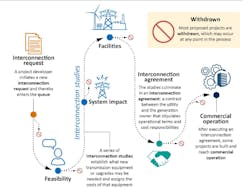Where Chinks Form in the Microgrid/Grid Relationship
Most microgrids in the continental US are connected to the grid. Those that aren’t tend to be on mountaintops, islands or other areas too remote from the grid to make connecting cost-effective or even possible.
But I’ve begun to notice incidents where this is not true – where microgrid owners are shunning a grid connection for other reasons. Their withdrawal stems from gnarly problems, not easily or quickly solved, which makes me wonder: Is grid defection with microgrids likely to become a trend?
Here are some of the main reasons microgrid customers cite for foregoing a grid connection, even when it's available to them.
Long wait to connect
Power plant developers — from those building large projects to microgrids — complain that it takes too long to interconnect to the grid. Some don’t want to wait for interconnection approvals, so they build their microgrid and begin operating it off grid with the intent of eventually connecting. Others choose to stay off the grid permanently.
The Lawrence Berkeley National Laboratory documented the severity of interconnection delays in a new report, which found that not only are the queues long, but they are getting longer. Interconnection wait times rose from about two years for projects built in 2000-2007 to nearly four years for those built in 2018-2022. The situation was even worse in 2022; the projects built that year had waited a median of five years to connect.
Now there is more power waiting to connect (~2,040 GW) than there is total installed capacity on the grid (~1,250 GW), according to the report. This may, in part, be because developers apply for interconnection early, before they have all of their ducks in a row to build the project, knowing that the interconnection wait can be long. If other aspects of the project fall through, they withdraw from the queue. Only 21% of projects in the queue eventually get built, according to historical data.
There is no simple solution to the problem. The Department of Energy has set up the Interconnection Innovation e-Xchange to create a road map toward improvement. But it won’t be easy given the myriad of rules and regulations that govern interconnection throughout the US at the utility, state and regional level.
Ineffective interconnection rules and other regulatory barriers stand in the way of building more microgrids and creating greater electric reliability as extreme weather keeps bombarding the grid.
“Breaking down the barriers and creating new rules is taking way too long,” said Mike Bakas, executive vice president of Ameresco, in a recent interview with Microgrid Knowledge. “As I’ve said many times, these destructive weather patterns are not waiting for us to get our act together.”
The grid is not clean enough
The US grid continues to rely heavily on fossil fuels to generate electricity. About 60% of the grid’s electricity is created by burning natural gas and coal, with variations by location. Use of grid power, therefore, makes it difficult for communities, businesses and institutions to reach carbon reduction goals. Some attempt to clean up their electricity supply by purchasing renewable energy certificates (RECs) with large solar and wind farms built in other states in some cases.
But the validity of RECs has come into question, particularly when they are derived from a virtual power purchase agreement. A study published in Nature finds that corporate REC purchases aren’t likely to prompt additional renewable energy production and create real emissions reductions.
This problem is raising some complex issues when it comes to green hydrogen production, as David Roberts of Volts discusses in a podcast, We're about to give billions of dollars to clean hydrogen. How should we define it? The US government is offering up to $100 billion in incentives to boost hydrogen, with the largest subsidies going to the production of the cleanest hydrogen. But electrolyzers use a lot of electricity to produce hydrogen and if that power comes from the grid, the hydrogen will not be green. Not surprisingly, most hydrogen production facilities being built so far are foregoing the grid and choosing to use on-site energy.
There are other reasons, too, to build off-grid microgrids. In places where electricity costs are high, it can be cheaper. For some it is ideological — they prefer to have local control of energy. And building off grid is not confined to large operations — one company has created a business model around bringing homes off grid.
No stampede
But there is little chance of a stampede off the grid any time soon because there are many benefits that a grid connection offers a microgrid.
Software and control technology allows microgrids to leverage a grid connection by buying and selling power and offering grid services, which becomes a means for the microgrid to earn revenue and lower its costs.
Microgrids also can be programmed to use the cleanest power available at any given time, whether that is grid power or the microgrid’s on-site energy. While this approach is unlikely to produce a 100% renewable energy supply, it does create an opportunity for a facility to use cleaner energy than if it relied on only grid power.
So the verdict is out on whether off-grid microgrids are a peculiarity or will become more widespread. We’re interested in your thoughts. Please comment on our Microgrid Knowledge LinkedIn Group, where we have posted a link to this story.
About the Author
Elisa Wood
Editor-in-Chief
Elisa Wood is the editor and founder of EnergyChangemakers.com. She is co-founder and former editor of Microgrid Knowledge.

